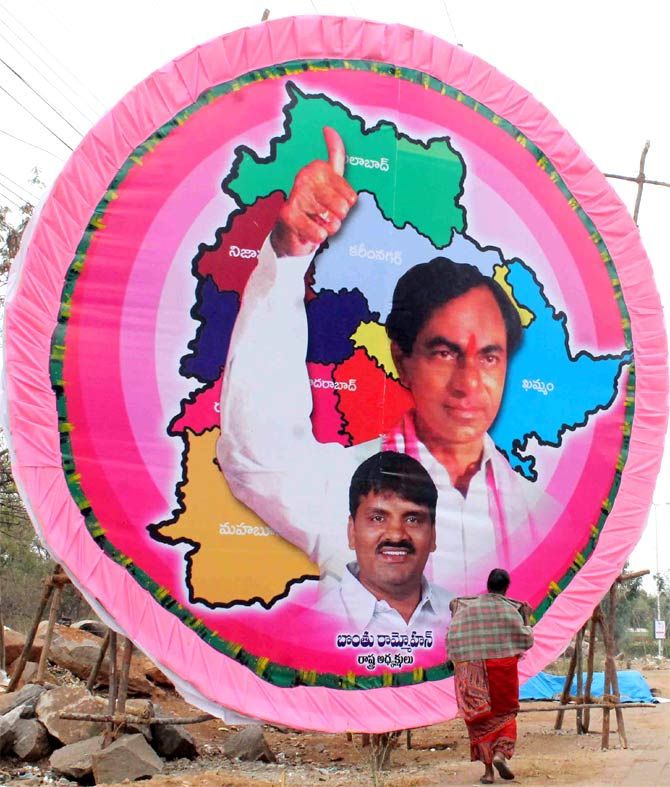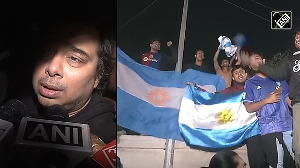 With almost 300 seats to the Lok Sabha being dominated by regional outfits, the Congress has added to the list by giving space to more regional forces in the Seema-Andhra and Telangana regions, says Saroj Nagi.
With almost 300 seats to the Lok Sabha being dominated by regional outfits, the Congress has added to the list by giving space to more regional forces in the Seema-Andhra and Telangana regions, says Saroj Nagi.
By ramming the Andhra Pradesh Reorganisation bill, 2014 in the Lok Sabha on Tuesday, the Congress has given space to the emergence of yet two more regional forces: Jaganmohan Reddy’s YSR Congress in the Seema-Andhra region and K Chandrashekhara Rao’s Telangana Rashtra Samiti in the Telangana region. In the process, it has virtually shut itself out as a dominant political party in the two regions of the state.
The latest development will see vast tracts of India being governed or dominated by regional outfits or region-based parties or national parties with a regional presence.
Such states account for around 300 of the 543 elective Lok Sabha seats, leaving most of the remaining states to be shared between the Congress and the Bharatiya Janata Party. Even in states like Maharashtra, which has 48 Lok Sabha seats, the two national parties find it difficult to form a government there without the participation of important regional players like the Shiv Sena or the Nationalist Congress Party.
The Telangana bill is likely to add one more element in the battle for the Lok Sabha in April-May.
Most of these regional parties are fervently hoping for a hung Parliament after the elections. While the Congress is seen to be on the downslide and the BJP on the upsurge, the growing tribe of non-Congress, non-BJP parties could, if they perform well in the Lok Sabha polls, mar if not spoil BJP’s prime ministerial nominee Narendra Modi’s dream of coming to power at the Centre.
Indeed, they have taken heart from pre poll opinion surveys where the BJP and the possible third frontiers seem to be running neck to neck even though most of these parties also have a track record of joining either the National Democratic Alliance or the United Progressive Alliance -- depending on who is in a position to form a government -- if they are unable to come together.
Notwithstanding this, most of these regional players see the 2014 national elections as providing them with the best available opportunity of exploring the possibility of forming yet another non-Congress, non-BJP national government at the Centre despite the failure of earlier experiments of this kind.
A number of leaders have already been talking about the possibility of such a government. Samajwadi Party leader Mulayam Singh Yadav has been openly soliciting the electorate to put him in a position where he will determine who will form the government at the Centre. Both Mamata Banerjee of the Trinamool Congress and Naveen Patnaik’s Biju Janata Dal have spoken of keeping equidistance from the BJP and the Congress, with civil rights agitationist Anna Hazare backing the West Bengal chief minister for the post. All India Anna Dravida Munnetra Kazhagam leader J Jayalalithaa too has thrown her cap -- or is it her cape? -- in the ring as a possible prime ministerial nominee. Janata Dal-United workers advocate this role for their leader Nitish Kumar.
While it is too early to assess the kind of role Jagan Reddy or Rao will play in the post poll scenario, there is little doubt that they could be among the determining factors in deciding who will form the next government at the Centre.
The Left too has stepped into its erstwhile role of trying to get the non-Congress, non-BJP parties on a common platform by holding a convention last October. A follow up exercise of the 14 potential partners was held in February. Meanwhile, regional leaders have been criss-crossing the country, holding talks on the proposed move. This includes Telugu Desam Party leader Chandrababu Naidu’s recent conversation with Banerjee on the issue.
Most advocates of a third front however realise two things: one, that such a coalition would be a post-election exercise and two, they would require a fulcrum around which such a coalition can be built. While the Left has often provided the moral or cementing force for such experiments, at other times, such coalitions have been backed either by the Congress (Chandrashekhar, Deve Gowda and I K Gujral governments for example) or by ideological opponents, the BJP and the Left (V P Singh government).
Given this backdrop, has the Congress shot itself in the foot by pushing for a separate Telangana and encouraging the rise of additional regional players?
There is no doubt that while Sonia is hailed virtually like a goddess in the Telangana region for her support for the bifurcation bill, she alongwith Prime Minister Manmohan Singh and Congress vice president Rahul Gandhi are unlikely to be forgiven by the Seema-Andhra people for it. More so, since the proposal to set up a separate state was preceded by the expulsion of the 16 Congress MPs from that region. Indeed, the expulsion and the passage of the bill has virtually spelt the political obituary of these leaders who will now have to painstakingly rebuild their political career.
“How can we go before the people in Seema-Andhra? They will ask us why we could not stop our own party from bifurcating the state while our colleagues from Telangana succeeded in their mission?” said one anguished MP from that region. “Our political careers are now at stake,” he added. Feeling betrayed by their own party, many of these MPs may now quit the Congress, with pepper sprayer L Rajagopal even declaring his intent to quit politics.
Given this backdrop, why did the Congress then push for the bifurcation bill?
Congress chooses between defeat and rout
Although several hurdles still remain in the creation of a new state, once it is formed, Telangana will get 17 parliamentary seats as against 25 for Seema-Aandhra out of the 42 Lok Sabha seats that united Andhra Pradesh presently has.
The state that the Congress once showcased as ‘model’ has been in turmoil ever since its chief minister Y S Rajashekar Reddy died in a helicopter crash in 2009 with his son Jagan seeking to occupy his father’s chair. The subsequent agitation on the Telangana issue virtually spelt the Congress’s obituary in the state.
The Congress now hopes to recoup some of its losses in the Telangana region where the TRS is a major force. Indeed, the Congress is hoping that the TRS will either merge his party or have a tie up with it so that the two of them together can sweep the region.
“The Congress is trying to translate its complete rout into a defeat,” quipped an opposition leader.
Both in 2004 and in 2009, the Congress came to power at the Centre on the strength on its handsome performance in Andhra Pradesh where it won 33 of the 42 Lok Sabha seats in 2009. This tally was expected to plummet to a single digit. The aftermath of the Telangana bill is expected to improve its chances in the Telangana region however and if the TRS plays ball with it, the two hope to even get 15 of the 17 seats.
But several imponderables remain.
The first of course is whether the TRS aligns, merges or jettisons the Congress once Telangana becomes a reality? When a decision is taken, TRS leaders say that they will have to take into account the fact that thousands of lives had been lost in their struggle for Telangana. Congress leaders, on their part, talk about a greater role for the TRS in the assembly polls and a greater share of seats to contest for the Congress in the national elections.
The second imponderable is why did the Congress push for a separate state at the cost of losing out completely in the rest of Andhra Pradesh? Is it because it had lost all hope of regaining a foothold in the Andhra region where it may not even get a single seat now and should instead try and recoup its losses by focusing on Telangana?
There is speculation that the Congress and the TRS would split the spoils of victory in this region with the Congress perhaps getting around eight to ten seats from there -- a number that may be a little more than what it would perhaps have got in united Andhra.
The third, of course, is the likelihood of providing another fertile ground to regional forces to grow while reducing its own geographic presence. Past experience has shown that whenever the Congress has played second fiddle to a regional player, it has either been marginalised or decimated as had happened in UP or Bihar.
Finally, all speculation that the Congress would try to bring Jaganmohan Reddy into the fold stand squashed with the passage of the Telangana bill. Reddy is the face of a united Andhra has been hitting out at the Congress top leadership over this move and has rechristened the Congress as the Italian National Congress.
Final Call
But the Congress has pressed ahead with the creation of Telangana in the hope of a preventing a complete washout in the state which it has once showcased as a model state. It hopes to add Telangana to its kitty of states where the party can be in power in alliance with a regional player. Much however would depend on how TRS leader views the situation.
Saroj Nagi is a senior journalist based in Delhi.










